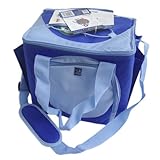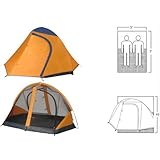
Average Reviews:

(More customer reviews)This is a great sleeping bag. Soft, and just right for California camping.
It is tall too. I like the build in cover.
Good Coleman product.
Click Here to see more reviews about:
Coleman Bluespring 30-Degree Rectangular Size Sleeping Bag (Tall)Product Description: The Coleman Bluespring 30-degree Tall Sleeping Bag is a comfortable three-season rectangular sleeping bag. At 33-inches by 80-inches, the tall-size Bluespring fits most body types up to six-feet-three-inches long. With four pounds of Hollofil-808 insulation, this moderate-temperature sleeping bag keeps you warm in temperatures down to 30-degrees Fahrenheit. Features include a cotton cover and cotton flannel liner that are commercial-machine washable, an exterior pocket, and the ability to zip two like-bags together for additional room.
All Coleman sleeping bags are designed with ComfortSmart technology to keep you comfortable. The Bluespring's ComfortSmart features include: ZipPlow which plows fabric away from the zipper to prevent snags, Comfort Cuff which surrounds your face with softness, Roll Control which locks the bag in place for easier rolling, Fiberlock which prevents insulation from shifting and increases durability, Thermlock which reduces heat loss through the zipper thereby keeping you warmer, Zipper Glide tailoring which allows smooth zipper operation around the corner, and the Wrap'N'Roll carrier which is attached so packing is easy.
Manufacturer's Warranty Limited five-year warranty
About Coleman The Coleman Company has been creating and innovating products for recreational outdoor use since W.C. Coleman started selling gasoline-powered lanterns in 1900. Inventor of the hugely popular fold-up camp stove, Coleman developed a plastic liner for his galvanized steel coolers in 1957--the birth of the modern cooler--and the company has been improving their utility and design ever since. The array of products that bear the Coleman name now includes just about everything you might need to work or play outdoors, from tents and sleeping bags to boats, backpacks, and furniture.
Amazon.com Sleeping Bag Guide Sleep Well: Finding the Right Sleeping Bag Sleeping bag technology has come a long way from the days of cowboy bedrolls. These days, there are a number of high-tech materials and designs available to keep you warm during the coldest outings. Here's a short list of things to keep in mind when you're shopping for a bag:
Buy for Cold It's a safe bet that on at least one of your adventures, the nighttime temperature will drop unexpectedly. That's why it's smart to buy a bag that's rated for the lowest possible temperature you expect to face on your camping and backpacking trips. For summer trips, a bag rated at +35 degrees or higher will likely do the trick. If you like to camp in higher elevations in the summer, or if spring and fall outings are in your future, consider bags rated from +10 to +35. Winter adventurers should look for bags in the -10 to +10 range, while those on serious winter alpine climbs and expeditions will want a bag rated lower than -10.
Keep in mind that sleeping bag manufacturers' temperature ratings only estimate the minimum temperature at which the bag will provide warmth. Take these numbers with a grain of salt, as different folks generate different amounts of heat when they sleep. If you're the type who likes to pile on the covers even on warmer nights, go for a bag that's rated ten degrees colder. The opposite is true for "warm" sleepers--a 35-degree bag will probably work for you on a 25-degree night.
Goose or No Goose? The most important component of any sleeping bag is its insulating material. Modern sleeping bags offer two choices: goose down or synthetic. While both materials have advantages and disadvantages, down bags are considered superior because of their phenomenal warmth-to-weight and warmth-to-bulk ratios. While providing great insulation, down is extremely compressible and light. There's a reason why geese can fly
and stay warm through the winter! Down also boasts great long-term durability and will typically retain its insulating properties after years of use.
All of that said, there are many high-quality synthetic bags on the market and synthetic materials are getting better all the time. While a synthetic bag will weigh somewhat more than a down bag at an equivalent temperature rating, synthetic bags perform better when wet. (Yes, the Achilles heel of down is that it loses all insulating properties when wet.) If your trips take you to wet climates, you may want to consider a synthetic bag for this reason alone. Keep in mind, too, that many people are allergic to down--synthetic bags are non-allergenic. Finally, down is considerably more expensive than synthetic, which might tip the balance for adventurers on a budget.
Bags for All Shapes Sleeping bags come in two basic shapes that reflect their intended use. Mummy-shaped bags offer the best warmth because they conform to the body's contours. This minimizes the amount of body heat the body must put out to maintain a constant temperature. Many mummy bags are offered in women-specific shapes and sizes, as well. Rectangular bags, while they do offer more room to toss and turn, are less thermally efficient because they contain more open air space. Also, they are typically heavier than mummy bags, and are generally not offered with down insulation, making them best suited for car camping or short backpacking trips.
Pad Yourself No matter what kind of bag you choose, a sleeping pad is a required accessory. Not only do they provide much-needed comfort when sleeping on the ground, pads also offer crucial warmth for your backside, as the weight of your body compresses--and renders virtually useless--the sleeping bag insulation that lies beneath you.
 Get 40% OFF
Get 40% OFF
Want to read more honest consumer review about Coleman Bluespring 30-Degree Rectangular Size Sleeping Bag (Tall) now ?












